Monday, 29 September, 2014. 09:52
We are waiting in Atocha Station in Madrid for our train to Zaragoza, which departs at 10:30. We got up at 07:30 to shower and then have breakfast in the hotel, before packing our bags and checking out. Today I tried the sunflowers seeds sprinkled over my cereal, only to discover too late that they had been salted! So I had to stir the salty seeds through the strawberry yoghurt to mask the saltiness.
We paid for the breakfasts as we checked out, then walked out into the cool morning air. It was a shirt walk to the Opera Metro station, where we caught the lift from the plaza down to the station, to avoid carrying our luggage down the stairs. We caught a train to Sol, and switched lines to get the train to Atocha Renfe, right below the long distance train station. Once here, we used a lift again and then went through baggage control, where they x-ray all luggage going on to a train. We are now sitting in an airport-style departure lounge area, with the platforms visible below us through glass walls. There are a lot of people waiting here; I presume many of them will be on our train, which goes to Barcelona, although we get off midway, at Zaragoza.
15:11. Hotel Catalonia El Pilar, Zaragoza.
We have arrived in Zaragoza and are taking a short break in our hotel room, since everything around here seems to be closed from 14:00 until either 16:00 or 17:00, including all the museums and cathedrals and other stuff we might want to see. We were silly and had lunch early, at about 13:30, when we should have been sightseeing and then taking a two hour lunch from 14:00!
 View from our room at Hotel Catalonia El Pilar. |
Our train arrived here on time at 11:45. We had to work out how to get to our hotel, and asked a woman in a tourist office at the station. She said we either had to take a taxi or the number 43 bus. We opted for the bus, which cost 1.35 euro each. It took a roundabout route which took maybe 25 minutes to get to the city centre and a stop within a few blocks walk from our hotel. We checked in to a fairly nice room, with a view over a tiled rooftop to a large church not far away.
After dropping our bags, we went for a walk. We are in the old city area, and there are many interesting things to see just a short walk away. Just one block west is the old Mercado Central building, which houses dozens of fresh produce sellers, as well as a handful of bakers and tiny cafes. M. bought some dried kiwifruit while I took some photos. She said she held up six fingers it indicate how many pieces she wanted, and the shopkeeper woman said, “kilos?” We very early ended up having dried kiwifruit for dinner!
 Mercado Central de Zaragoza. |
Next to the market are the ancient Roman walls of Caesar Augustus, with an 80 metre long fragment surviving. These lead north to the main Plaza del Pilar, on which stands the Basilica del Pilar, a huge cathedral with four towers at the corners and a large central dome, then numerous smaller domes which are tiled with diamond patterns in green, yellow, and white. We had wanted to get some sort of lunch in the market, but it was all unprepared food, so we sat at the cafe El Real which faces the basilica from across the plaza, and ordered some sandwiches. M. got a sandwich vegetables, while I chose the lomo iberico, a sandwich with Spanish ham and brie. I also ordered a lemon granita, which M. liked the look of so much that she got a mandarin one too after finishing her cappuccino.
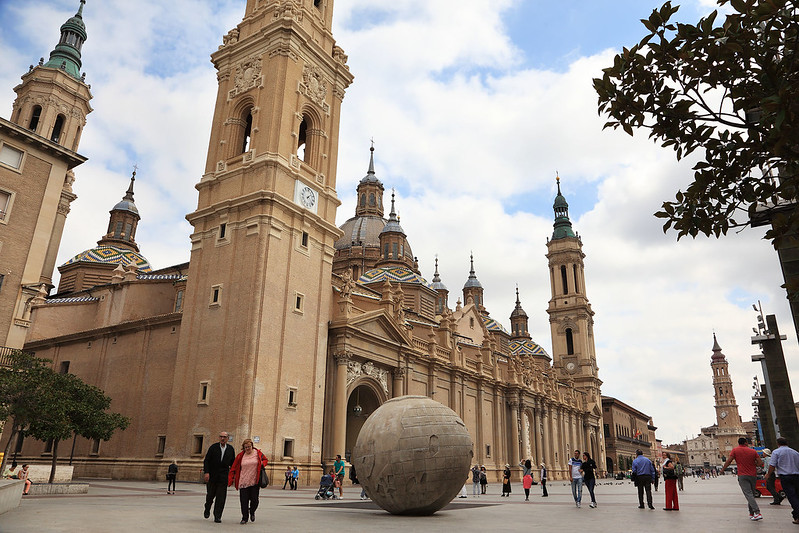 Plaza del Pilar and the Basilica del Pilar. |
18:26
After lunch, we walked down the main shopping drag of the old city, Calle Alfonso I, towards the new Plaza España. There we turned to go have a look at the old Roman theatre of Caesar Augustus. This is an amazing Roman ruin right in the heart of the city, taking up a whole block. From the street you can see through an iron fence down into the amphitheatre, which is covered with a high translucent roof, presumably to protect it from rain. We wanted to go in, and the museum entrance looked open, but when we went inside the man at the desk said the museum was closed today. It seemed odd to have the doors open and a man sitting at the desk just to do that, rather than just locking the doors.
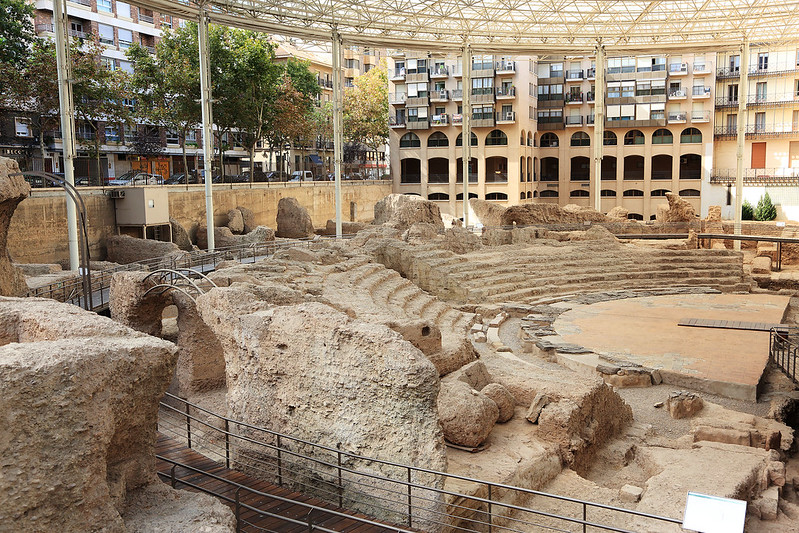 The Roman theatre of Caesar Augustus. |
Most everything else seemed to be closed at this time too, including most of the shops we walked past, which were apparently having a siesta break. We decided to go back to our hotel for a bit of a rest and emerge again at 16:00 when things began opening again.
The first place we went was the Catedral del Salvador, known as La Seo. This is the old cathedral, begun in the 12th century and mostly completed around 1520. It has recently undergone major restoration work, and looked in very good condition. The interior is a large square shape with a choir and organ in the middle, surrounded by various chapel alcoves, each one ornately decorated with paintings or sculptures, with masses of gold and silver everywhere. On one corner of the cathedral was a door to an adjacent building in which is housed a tapestry museum. Entrance to this was included in the 4 euro admission to the cathedral. There were three large display rooms with half a dozen or so huge tapestries in each, dating from various times from about 1500 to 1700, if I read the Spanish signs correctly. They were amazing, with very detailed work illustrating various scenes with religious themes or depicting events in the lives of kings. The colours were muted but recognisable as reds, blues, and greens, with small bits of yellow, and in one case a surprising dash of orange. There was no perspective, with people in the distant backgrounds depicted the same size as people in the foreground. Unfortunately no photography was allowed.
11:00
After finishing the tapestries and the cathedral, we walked the short distance across the main square to the Basilica del Pilar, which is a much newer cathedral, I think. This was not quite as impressive inside and we walked around it fairly quickly. There was also a mass taking place inside at the time, though there was plenty of room to walk around the central area where that was happening and several other people were doing so. We exited the north west corner, where you could take a lift up one of the four towers on the corners of the rectangular cathedral. This cost three euro, but was well worth it when the glass lift took us up the tower, showing us views of the city below as it did so through the open structure of the tower. It left us near the top of the main brickwork, just under the arches supporting a narrower tower and small dome above. We climbed up a few flights of stairs from there and then finally a tight spiral staircase until we emerged in a cramped space where eight thin pillars supported the very top dome just above us. The view from the tower was spectacular, over the entire city of Zaragoza, and over the cathedral itself and other nearby historic buildings.
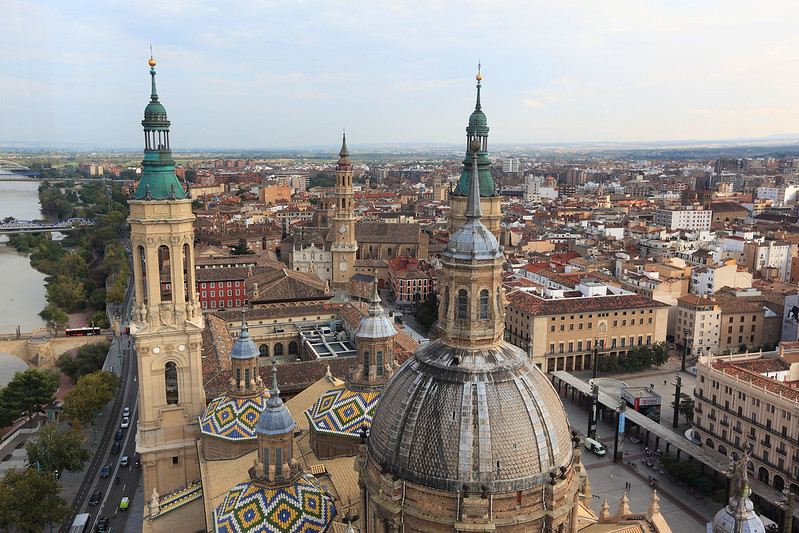 View from top of Basilica del Pilar. |
Once back on ground level, we crossed the street to walk along the river bank a bit, and make a large circuit around both cathedrals and the main square to see a bit more of the old city before returning to our hotel to pick up my tripod for an evening of photography. We ducked into a supermarket to buy some chocolate and a banana. The supermarket entrance was tiny, but hidden behind it was a huge maze of product aisles, snaking throughout much of the ground floor of the buildings on the block, no doubt. When we got to the checkout, the lady there asked something in Spanish which we didn’t understand. Thankfully the woman in front of us who was packing her groceries to take out translated, saying we were supposed to weigh the fruit and get a printed sticker with the price on it. The cashier had another employee race back with the banana to the fruit section and price it for us, while she served another customer.
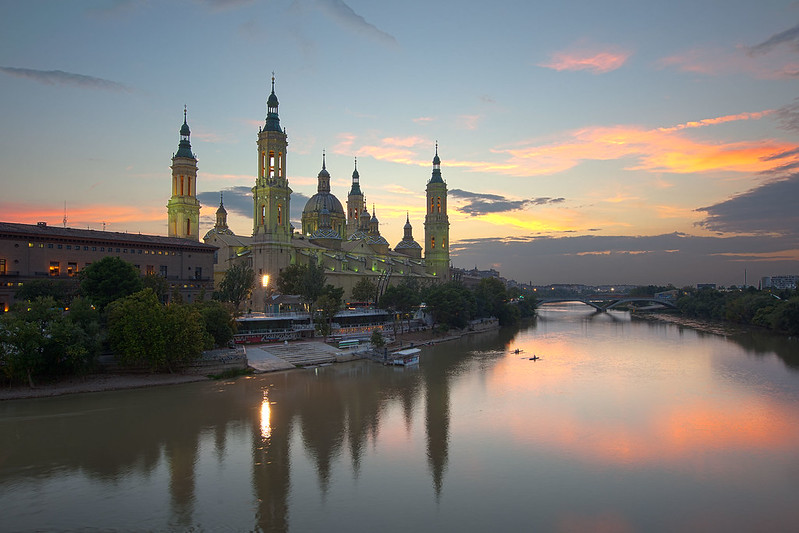 Basilica del Pilar from across the Ebro River. |
Back at the hotel we checked the time of sunset today (19:49) and had a brief rest before heading out with camera and tripod. We walked to the Puente de Piedra, an old multi-span stone arch bridge which looks as if it could well be Roman construction. (Later research revealed the bridge to be a 15th century construction.) It is now used for pedestrians and a single lane of one-way traffic restricted to buses and taxis. At the arch pillars there are semicircular projections out above the river. We staked a spot in one of these to take tripod photos of the Basilica del Pilar as the sun set beautifully behind it, illuminating scattered cloud with orange and pink, all reflected in the river. Around 20:00 the foot traffic across the bridge increased considerably, presumably as people walked home from work. As the sky darkened we moved to a spot on the far bank of the river, so we could get a shot of the lit bridge in the foreground of the cathedral as well.
 Basilica del Pilar and Puente de Piedra. |
Photos done, we walked back across the bridge to the old city to seek a place for dinner. As we came back, we saw a couple having wedding photos on the bridge, with the basilica in the background. By now it was after 20:30, so we hoped it wouldn’t t be too hard to find an open restaurant. We stumbled across the Ristorante e Pizzeria La Tagliatella, which looked so good that we walked inside. A hand painted sign near our table was in Italian, so I could read most of it, and it said that they made all their pasta by hand using the finest fresh ingredients, and the chef was a pasta maestro from Liguria. (Later research after we got home from Spain revealed La Tagliatella to be a large chain of restaurants, with dozens of them all over Spain, and a few other countries. We had no idea at the time.)
We had a menu in English, which contained dozens of pastas and sauces, as well as pizzas, calzones, antipasti, and various other Italian dishes. As well as a quattro formaggi pizza, there was a sei formaggi, with six(!) cheeses. M. ordered that, and the waitress’s eyes widened and her eyebrows raised and she did a “woo” gesture with her lips. I was tempted by a calzone, and we also ordered some focaccia sticks as a starter, six of which came, two each topped with olives, tomato, and onion. When the main meals came, we were stunned by the sizes of both the pizza and the calzone. The pizza overlapped a huge plate, while the calzone was almost the size of a football. The crusts were paper thin though, and the calzone was mostly inflated with air, so the actual volume of food was reasonable enough that we finished it all. The fact that it was delicious helped!
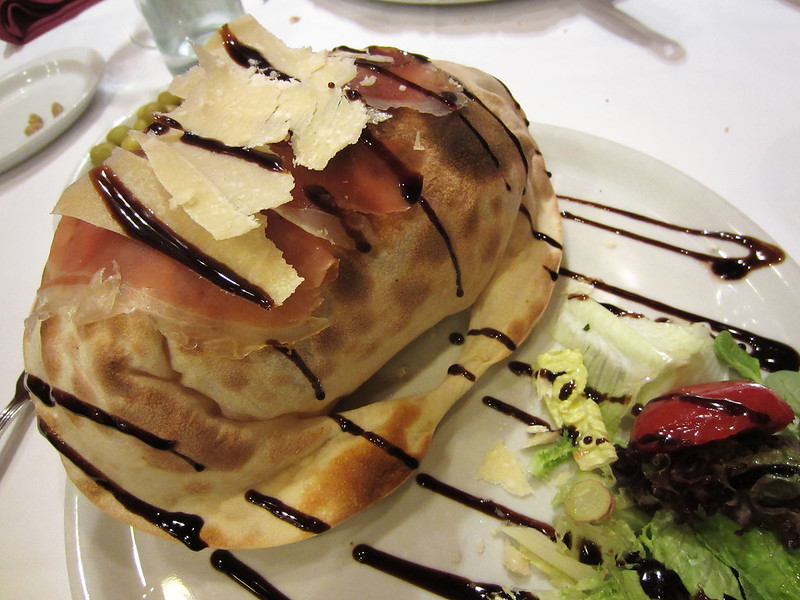 Calzone from La Tagliatella. |
For dessert I wanted the cheesecake, but the waitress returned to say that alas they were out of it. So I ordered some gelato instead, pointing at the flavour strawberry on the menu and saying, without thinking, “fraise“. So here I was, in Spain, in an Italian restaurant, speaking French! I just needed to add insha’Allah to get Arabic in there too. I also got the peach flavour gelato. Both flavours were very good, with small chunks of fruit in them. When paying the bill I used a bit of rehearsed Spanish from our phrase book on the waitress, saying the meal was excellent.
After the meal we walked back to our hotel, stopping in the Calle Alfonso I to take a couple of tripod shots of the street and the cathedral at the end of it. Then we returned to our room and turned in for the night.
